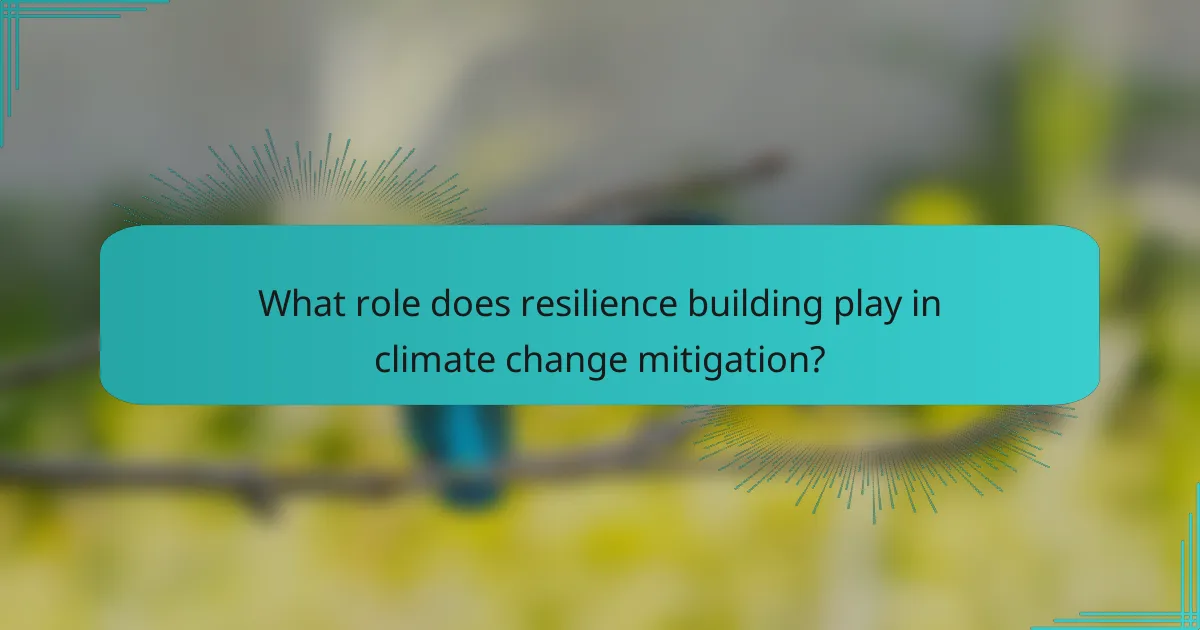Climate change mitigation practices are crucial in addressing the pressing environmental challenges we face today. By focusing on reducing carbon footprints, enhancing community resilience, and promoting collective action, individuals, businesses, and governments can work together to foster a sustainable future. Through initiatives that prioritize renewable energy, efficient transportation, and effective resource management, communities can significantly lower greenhouse gas emissions and better adapt to climate-related impacts.

What are effective climate change mitigation practices in Australia?
Effective climate change mitigation practices in Australia focus on reducing carbon footprints, enhancing resilience, and fostering community action. These practices encompass various strategies that individuals, businesses, and governments can implement to combat climate change and promote sustainability.
Renewable energy adoption
Adopting renewable energy is crucial for reducing greenhouse gas emissions in Australia. This includes utilizing solar, wind, and hydroelectric power, which can significantly lower reliance on fossil fuels. For instance, many households are installing solar panels, which can reduce energy costs and carbon footprints by a substantial margin.
Community initiatives, such as solar farms and wind projects, can also play a vital role in transitioning to cleaner energy sources. Engaging with local governments to support renewable energy policies can further enhance these efforts.
Energy efficiency improvements
Improving energy efficiency is a practical way to mitigate climate change impacts. This can be achieved through upgrading appliances, enhancing insulation, and implementing smart home technologies. For example, using LED lighting and energy-efficient heating systems can reduce energy consumption by up to 50% compared to traditional options.
Businesses can also benefit from energy audits to identify areas for improvement. Implementing energy-saving measures not only cuts costs but also contributes to overall emissions reduction.
Sustainable agriculture techniques
Sustainable agriculture techniques are essential for reducing the carbon footprint of food production in Australia. Practices such as crop rotation, organic farming, and agroforestry can enhance soil health and increase biodiversity. These methods help sequester carbon in the soil while reducing reliance on chemical fertilizers.
Farmers can also adopt water-efficient irrigation systems to conserve resources and minimize environmental impact. Supporting local food systems through farmers’ markets can further promote sustainability and reduce transportation emissions.
Waste reduction strategies
Implementing waste reduction strategies is vital for mitigating climate change. This includes practices like recycling, composting, and reducing single-use plastics. Communities can organize clean-up events and educational campaigns to raise awareness about waste management.
Businesses can adopt circular economy principles, focusing on reusing materials and minimizing waste. Establishing clear recycling programs can significantly decrease landfill contributions and lower greenhouse gas emissions.
Carbon offset programs
Carbon offset programs allow individuals and businesses to compensate for their emissions by investing in projects that reduce greenhouse gases. In Australia, this can include funding reforestation, renewable energy projects, or methane capture initiatives. Participating in these programs can help balance out unavoidable emissions from activities like travel or manufacturing.
Choosing reputable carbon offset providers is essential to ensure that contributions lead to genuine environmental benefits. Regularly reviewing and adjusting offset strategies can enhance their effectiveness in achieving climate goals.

How can communities reduce their carbon footprint?
Communities can effectively reduce their carbon footprint through collaborative efforts that focus on sustainable practices. By implementing initiatives that promote renewable energy, efficient transportation, recycling, and green spaces, communities can significantly lower greenhouse gas emissions and enhance resilience.
Community solar initiatives
Community solar initiatives allow residents to invest in or subscribe to solar energy projects, making renewable energy accessible to those who cannot install solar panels on their properties. These programs can reduce reliance on fossil fuels and lower electricity costs for participants.
To start a community solar project, local governments or organizations can identify suitable sites for solar installations and engage community members through informational sessions. It’s essential to consider financing options, such as grants or partnerships with solar developers, to make the project financially viable.
Public transportation enhancements
Enhancing public transportation systems can significantly reduce the carbon footprint by encouraging more people to use buses, trains, and other forms of mass transit instead of personal vehicles. Improvements may include increasing service frequency, expanding routes, and integrating eco-friendly vehicles.
Communities should assess current transportation needs and invest in infrastructure that supports sustainable transit options. For example, implementing dedicated bus lanes or bike-sharing programs can promote alternative modes of transport, ultimately decreasing traffic congestion and emissions.
Local recycling programs
Local recycling programs help divert waste from landfills, reducing methane emissions and conserving resources. Effective programs typically include curbside pickup, drop-off centers, and educational campaigns to inform residents about proper recycling practices.
To enhance recycling efforts, communities can establish clear guidelines on what materials are recyclable and provide accessible bins in public spaces. Regular community clean-up events can also foster engagement and raise awareness about the importance of recycling.
Urban green spaces development
Developing urban green spaces, such as parks and community gardens, contributes to carbon footprint reduction by improving air quality and promoting biodiversity. These areas can act as carbon sinks, absorbing CO2 while providing recreational opportunities for residents.
Communities can prioritize green space development by identifying underutilized land and collaborating with local organizations to design and maintain these areas. Incorporating native plants and trees can enhance ecological benefits while requiring less maintenance and water.

What role does resilience building play in climate change mitigation?
Resilience building is essential in climate change mitigation as it enhances a community’s ability to withstand and recover from climate-related impacts. By strengthening infrastructure, improving disaster preparedness, and managing resources effectively, communities can reduce their vulnerability and adapt to changing environmental conditions.
Infrastructure upgrades
Upgrading infrastructure is a critical component of resilience building. This includes reinforcing buildings, bridges, and roads to withstand extreme weather events, such as floods and hurricanes. For example, using flood-resistant materials and designs can significantly lower damage costs and recovery time.
Communities should prioritize investments in green infrastructure, such as permeable pavements and green roofs, which can absorb rainwater and reduce urban flooding. Engaging local contractors and suppliers can also stimulate the economy while enhancing resilience.
Disaster preparedness training
Disaster preparedness training equips individuals and organizations with the skills to respond effectively during emergencies. This training often includes evacuation plans, first aid, and communication strategies, ensuring that communities can act swiftly when disasters strike.
Regular drills and workshops can help reinforce these skills. Local governments can collaborate with community organizations to provide accessible training sessions, ensuring that all residents, including vulnerable populations, are prepared for climate-related events.
Water resource management
Effective water resource management is vital for building resilience against climate change impacts. This involves strategies such as rainwater harvesting, efficient irrigation systems, and the protection of watersheds to ensure a sustainable water supply during droughts or floods.
Communities should assess their water needs and implement conservation practices, such as xeriscaping or using drought-resistant plants in landscaping. Establishing a local water management committee can help coordinate efforts and ensure equitable access to water resources.

How can individuals contribute to climate change mitigation?
Individuals can play a crucial role in climate change mitigation by adopting practices that reduce their carbon footprint, build resilience, and foster community action. Simple lifestyle changes and local engagement can collectively make a significant impact on the environment.
Reducing personal energy consumption
Reducing personal energy consumption is a direct way to lower your carbon footprint. Simple actions like turning off lights when not in use, using energy-efficient appliances, and opting for public transport can lead to substantial energy savings.
Consider conducting an energy audit at home to identify areas for improvement. You might find that switching to LED bulbs or unplugging devices when not in use can reduce energy bills and emissions by a noticeable percentage.
Supporting local businesses
Supporting local businesses helps reduce transportation emissions and stimulates the local economy. By purchasing goods from nearby stores or farmers’ markets, you contribute to a sustainable community that prioritizes local resources.
Choose to buy seasonal produce or locally made products, which often have a lower carbon footprint compared to imported items. This not only supports local entrepreneurs but also encourages sustainable practices within your community.
Participating in tree planting events
Participating in tree planting events is an effective way to contribute to climate change mitigation. Trees absorb carbon dioxide, improve air quality, and enhance biodiversity, making them vital for a healthy ecosystem.
Look for local organizations that host tree planting initiatives. Engaging in these events not only helps the environment but also fosters community spirit and raises awareness about the importance of reforestation.

What are the prerequisites for effective community action?
Effective community action requires strong local engagement and access to necessary resources. These elements ensure that initiatives are well-supported and aligned with the community’s needs and goals.
Community engagement strategies
Successful community engagement strategies involve actively involving residents in decision-making processes. This can include organizing workshops, surveys, and public meetings to gather input and foster collaboration.
Building trust is essential; consider forming partnerships with local organizations and leaders to enhance credibility. Utilize social media and local events to raise awareness and encourage participation in climate action initiatives.
Access to funding and resources
Access to funding is crucial for implementing community action projects. Local governments, non-profits, and private foundations often provide grants or financial support for initiatives focused on climate change mitigation.
Communities should explore various funding sources, including federal programs and local initiatives, to secure necessary resources. Establishing a clear budget and outlining project goals can help in attracting potential funders.

How do government policies influence climate action in Australia?
Government policies in Australia play a crucial role in shaping climate action by establishing frameworks for carbon reduction and resilience building. These policies can incentivize community action and guide businesses towards sustainable practices.
Carbon pricing mechanisms
Carbon pricing mechanisms are tools used by governments to encourage the reduction of greenhouse gas emissions. In Australia, this includes systems like the Emissions Reduction Fund and the Safeguard Mechanism, which set financial costs on carbon emissions to motivate businesses to lower their carbon footprints.
These mechanisms work by assigning a price to carbon emissions, making it more expensive for companies to pollute. For example, businesses that exceed their emissions limits may need to purchase carbon credits, which can lead to significant financial savings if they invest in cleaner technologies instead.
When implementing carbon pricing, it is essential to consider the potential economic impacts on industries and consumers. Policymakers should ensure that the pricing structure is fair and provides support for vulnerable communities, helping them transition to greener practices without facing undue hardship.

